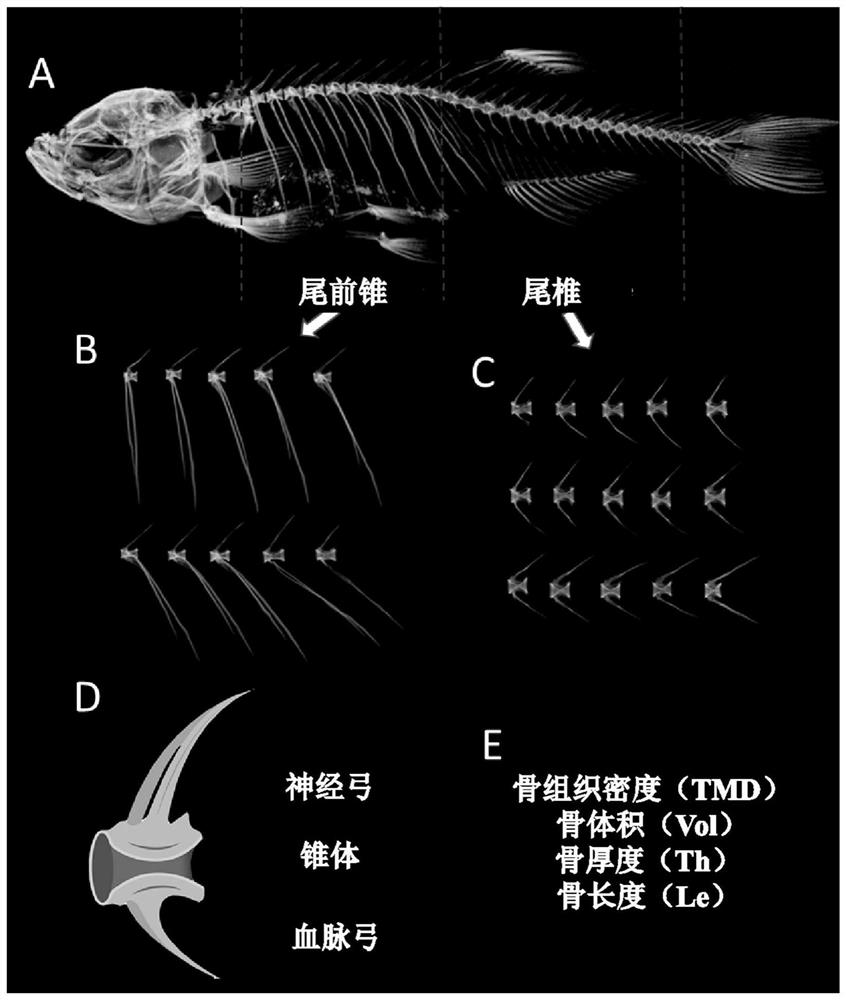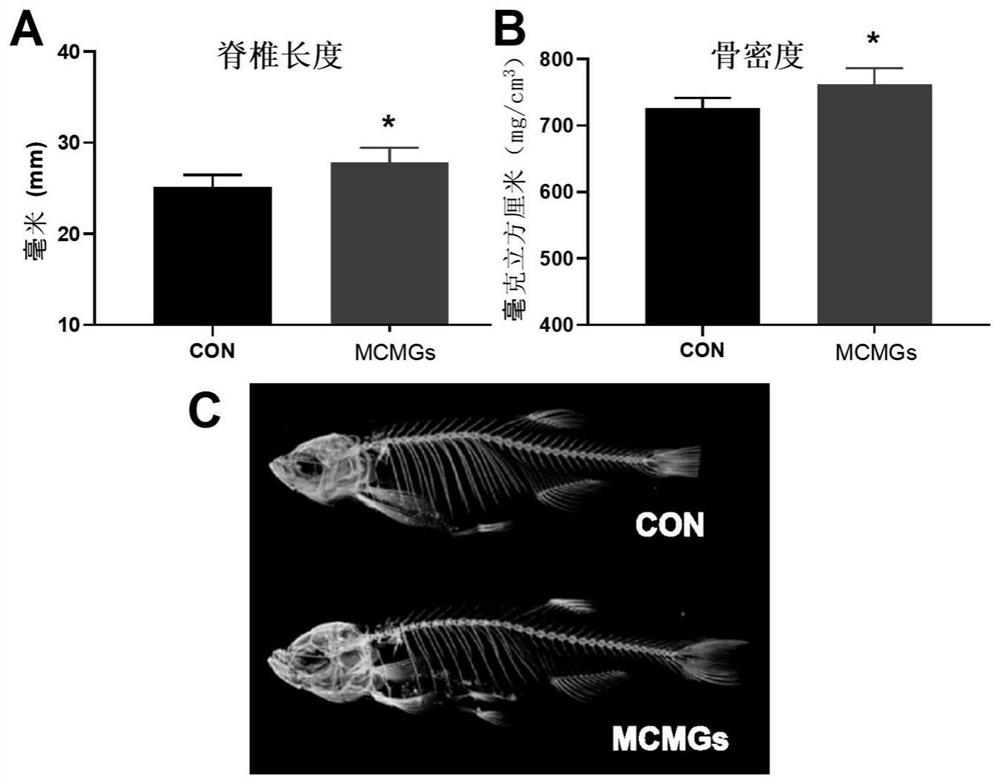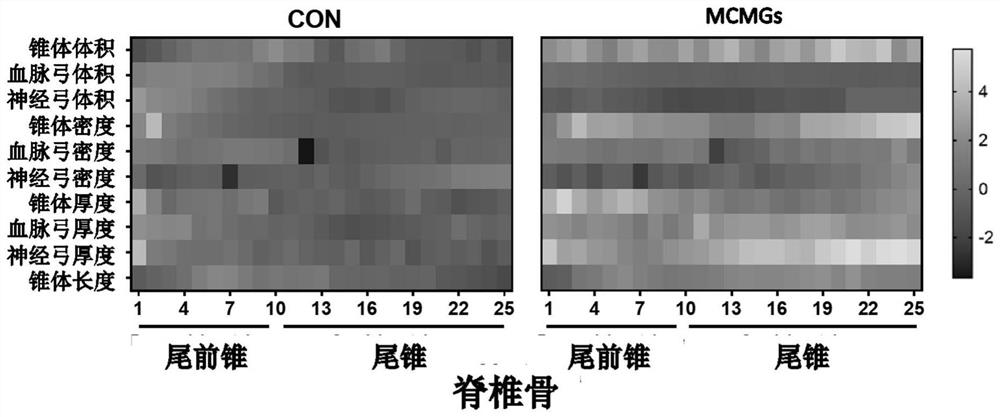Application of medium-chain fatty acid monoglyceride composition in preparation of products for promoting bone growth
A technology of medium-chain fatty acid and caprylic monoglyceride, applied in products, in the field of medium-chain fatty acid monoglyceride composition, to achieve good practicability, increase bone density, and promote bone growth
- Summary
- Abstract
- Description
- Claims
- Application Information
AI Technical Summary
Problems solved by technology
Method used
Image
Examples
Embodiment 1
[0054] To verify the effect of MCMGS (weight ratio of lauric acid monoglyceride, capric acid monoglyceride and caprylic acid monoglyceride, 3:1:1, 750 mg / kg) on zebrafish spine length, bone mineral density and bone phenotype, It can be understood that the ratio in brackets is the weight ratio of lauric acid monoglyceride, capric acid monoglyceride and caprylic acid monoglyceride in MCMGs, and the dose in brackets is the administered dose of MCMGs. The subsequent examples are based on this reasoning, not Repeat.
[0055] experimental method
[0056] A total of 144 three-month-old AB-type zebrafish with healthy physique and consistent specifications were selected and randomly divided into 2 groups after pre-rearing for 7 days, the control group (CON) and the experimental group (MCMGS). 16:00), were fed basal feed and custom basal feed containing 750mg / kg MCMGS, the experimental period was 8 weeks. Each group of 4 repetitions, each repetition of 18 fish, were placed in 8 10L ...
Embodiment 2
[0061] To verify the effect of MCMGS (weight ratio of lauric acid monoglyceride, capric acid monoglyceride and caprylic acid monoglyceride, 2:1:0.5, 1500 mg / kg) on zebrafish spine length, bone mineral density and bone phenotype.
[0062] experimental method
[0063] It is roughly the same as Example 1, except that the ratio of MCMGs and the administered dose are 1500 mg / kg.
[0064] Experimental results
[0065] After obtaining a large number of bone indexes, referring to the method of Hur et al., using Z-score analysis, the bone indexes of each vertebra were standardized, as follows: For a certain bone index of each part, the value of the index was compared with that of the control group. The difference between the means of all vertebrae was divided by the standard deviation of all vertebrae in the control group. These normalized data are then visualized to generate heatmaps ( image 3 ) to compare trends in skeletal phenotypes. Through the heat map of phenotype, it can...
Embodiment 3
[0069] To verify the effect of MCMGS (weight ratio of lauric acid monoglyceride, capric acid monoglyceride and caprylic acid monoglyceride is 1:1:0.1, 150 mg / kg) on the expression of bone metabolism-related genes in zebrafish.
[0070] experimental method
[0071] It is roughly the same as Example 1, except that the ratio of MCMGs (1:1:0.1), its administration dose is 150 mg / kg, and the detected index is the expression of bone metabolism-related genes.
[0072] Experimental results
[0073] The results of skeletal phenotype showed that the improvement effect of 150mg / kg MCMGS on zebrafish bone development was mainly concentrated in the caudal part of the spine, which significantly promoted the bone development and mineral deposition in the caudal part. To further explore the regulatory effect of MCMGS on bone formation in the caudal vertebra of zebrafish, this study detected osteogenic marker genes in the caudal vertebra, such as Figure 5 shown. The expressions of runx2b...
PUM
 Login to View More
Login to View More Abstract
Description
Claims
Application Information
 Login to View More
Login to View More - R&D
- Intellectual Property
- Life Sciences
- Materials
- Tech Scout
- Unparalleled Data Quality
- Higher Quality Content
- 60% Fewer Hallucinations
Browse by: Latest US Patents, China's latest patents, Technical Efficacy Thesaurus, Application Domain, Technology Topic, Popular Technical Reports.
© 2025 PatSnap. All rights reserved.Legal|Privacy policy|Modern Slavery Act Transparency Statement|Sitemap|About US| Contact US: help@patsnap.com



